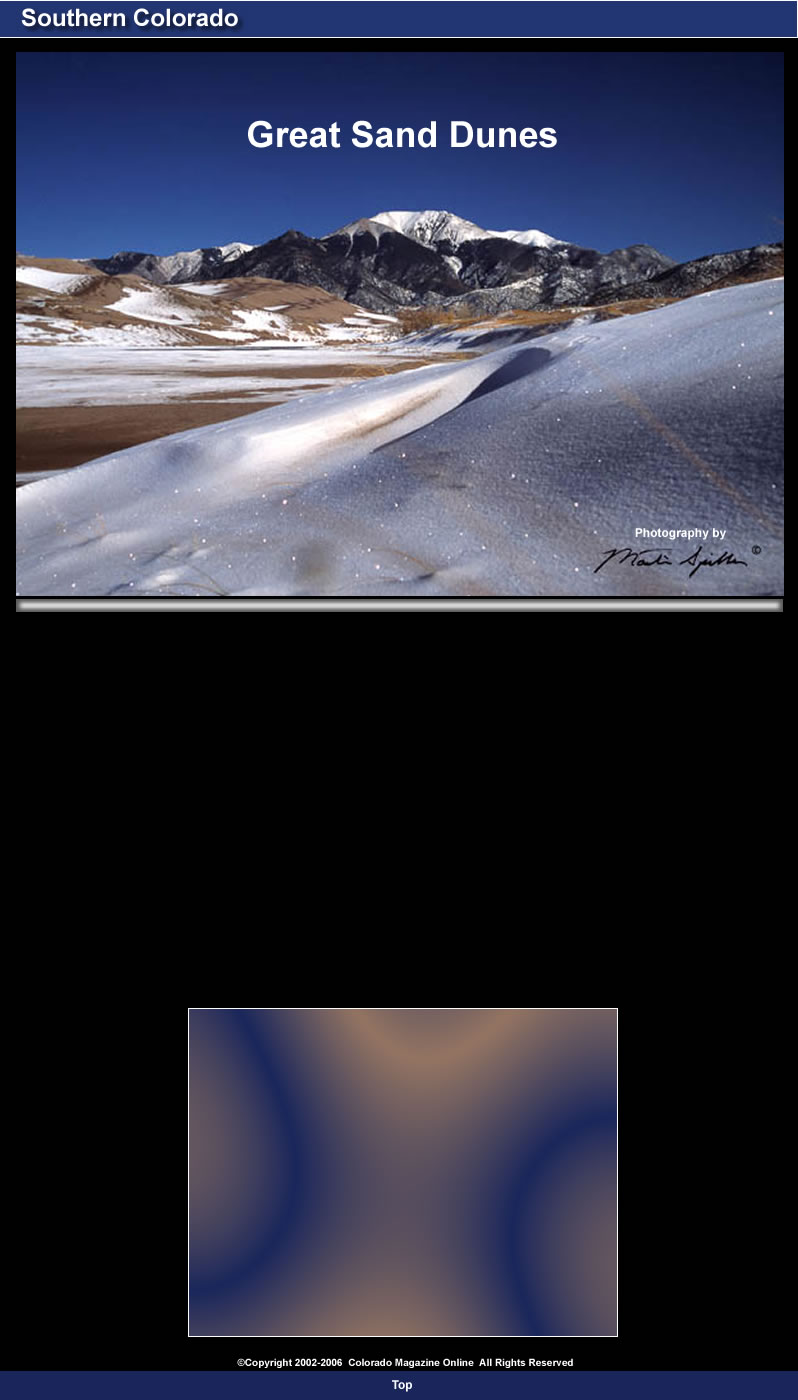The massive sand dunes, which became a national monument in 1932 with the passage of the Great Sand Dunes National Park and Preserve Act, are spread over 30 square miles. At some points the dunes, which the tallest sand dunes in North America, rise to a height of 750 feet. The sand dunes are situated in a high mountain valley on the eastern side of the San Luis Valley, between the Blanca Massif and Crestone Needle in southern Colorado. Alamosa is about 35 miles to the south, on U.S. Highway 160.
The dunes are the result of wind and rain that have eroded the San Juan and Sangre de Cristo Mountains over the millennia. The dunes collect as prevailing winds blowing across the San Luis Valley meet winds blowing in the opposite direction. These crosswinds cause the sand to drop to the valley floor, where it continuously builds up. The dunes formation is held in place by water flowing from the Sangre de Cristo's. Although the vast sculptured shapes of the dunes are continually shifting form, they maintain remarkable stability because they stay so moist from the rain and snow throughout the year.
Winter scenes, as captured by photographer, Martin Spilker, depict the dunes’ solitude and quiet beauty, as well as their propensity to be interrupted by sudden storms. Winter at the sand dunes generally brings sunny, but chilly, clear days and nights. But the valley’s intense alpine sun can still warm the sand even on those days. At an elevation of 8200 feet, blizzards and subzero temperatures may occur at night. Summer temperatures average in the 80's, with lows at night averaging in the 40's. July and August can bring heavy afternoon rainstorms with dazzling lightning performances. In average to wet years, the Medano Creek, which runs through the sand dunes, begins to flow as a trickle in early April, then becomes a wide, fast-flowing stream at its peak in early summer. Be prepared to fight off hordes of mosquitoes and gnats in the springtime. Unless the mountain snowpack is high, the creek usually begins recede by mid-summer.
The Great Sand Dunes National Park and Preserve Act of 2000 mandated the purchase of the 97,000-acre Baca Ranch to create the National Park, the Baca National Wildlife Refuge and to make significant additions to the Rio Grande National Forest. Part of the 103,000-acre Zapata-Medano Ranch, owned and operated by the Nature Conservancy, is included in the National Park and the Baca National Wildlife Refuge.
About 300,000 people visit the park annually. The Visitor Center is open from 9:00 AM to 6:00 PM, Memorial Day to Labor Day. Hours vary the rest of the year. The Center offers a a video presentation, exhibits, a bookstore, first aid room, a back porch with viewing scope, and rangers to answer questions and provide assistance. You can call (719) 378-6399 to reach a ranger at the Visitor Center. The area’s Piñon Flats Campground is open all year, with accessible restrooms and running water.
With the exception of the Oasis store and restaurant, located just outside the park entrance, few other gas, food or lodging facilities are open nearby. However, full services are available year-round in nearby Alamosa.


